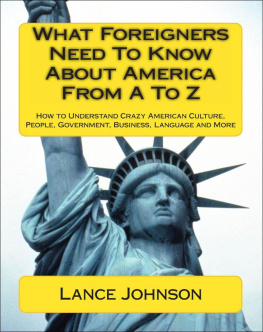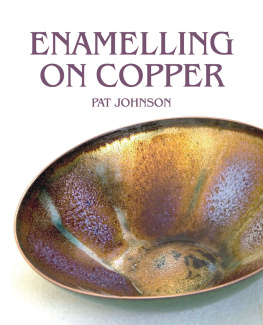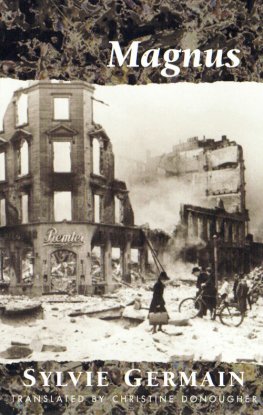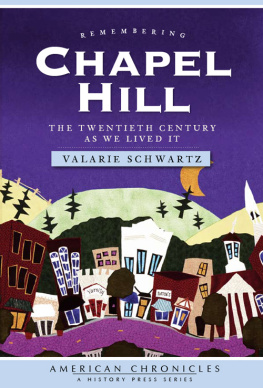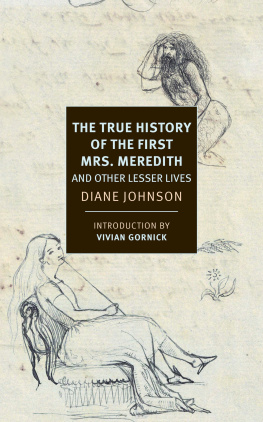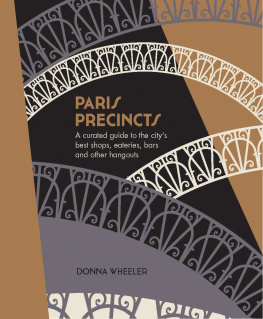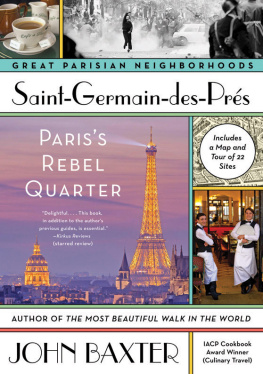Lesser Lives: The True History of the First Mrs. Meredith
I NTO A P ARIS Q UARTIER
R EINE M ARGOTS C HAPEL AND OTHER H AUNTS of S T .-G ERMAIN
D IANE J OHNSON
NATIONAL GEOGRAPHIC DIRECTIONS
NATIONAL GEOGRAPHIC
Washington, D.C.
Published by the National Geographic Society
1145 17th Street, N.W., Washington, D.C. 20036-4688
Text copyright 2005 Diane Johnson
Map copyright 2005 National Geographic Society
Photography credits: Courtesy of the author; Monica Ekman; Anne Randerson; David Scherman/Getty Images
All rights reserved. No part of this book may be reproduced or transmitted in any form or by any means, electronic or mechanical, including photocopying, without permission in writing from the National Geographic Society.
Library of Congress Cataloging-in-Publication Data:
Johnson, Diane, 1934
Into a Paris quartier : Reine Margots Chapel and other haunts of St.-Germain / Diane Johnson
p. cm. (National Geographic directions)
ISBN-13: 978-1-4262-0183-7
ISBN-10: 1-4262-0183-4
1.Saint-Germain-des-Prs (Paris, France : Quarter)History. 2. Saint-Germain-des-Prs (Paris, France : Quarter)Intellectual life. 3. Saint-Germain-des-Prs (Paris, France : Quarter)Description and travel. 4. Paris (France)History. 5. Paris (France)Intellectual life. I. Title. II. Series.
DC752.S25J64 2005
944.361dc22
2005041514

Founded in 1888, the National Geographic Society is one of the largest nonprofit scientific and educational organizations in the world. It reaches more than 285 million people worldwide each month through its official journal, N ATIONAL G EOGRAPHIC, and its four other magazines; the National Geographic Channel; television documentaries; radio programs; films; books; videos and DVDs; maps; and interactive media. National Geographic has funded more than 8,000 scientific research projects and supports an education program combating geographic illiteracy.
For more information, please call 1-800-NGS LINE (647-5463), write to the Society at the above address, or visit us online at www.nationalgeographic.com
For John Murray, as ever
I NTO A P ARIS Q UARTIER

I NTRODUCTION
The worlds quintessential expatriate city, Paris has long held a special fascination for Americans. Offering an incomparable urban setting, a rich cultural legacy and a deep-rooted respect for artistic pursuits and individual freedom, the French capital has provided a stimulating environment for successive waves of celebrated American migrs.
G UIDE M ICHELIN , P ARIS
As the travelers bible, the Guide Michelin, suggests, maybe the feeling Americans have for Paris is unlike that of other visitors. Maybe we need it more. The English, it seems, can take the city or leave it, full as it is of French people: Many an Englishman has harboured a secret admiration for Parisif it were not for the Parisians, as the editor acknowledges. The Spanish, the Swedish are seldom seen here; these nations have beautiful places of their own. But the City of Light has haunted the American imagination from the days of Benjamin Franklin and Thomas Jefferson, the reflex of our aspirations, and, some might say, feelings of cultural inferiority or at least of newness. Paris has also occupied a significant place in our literature, from Henry Jamess bemused innocents to Hemingways worldly pub-crawling expatriates.
And, like Jeffersons, like Gertrude Steins, the American imagination has tended to fasten on a particular part of Paris: the Left Bank around the church of St.-Germain-des-Prs. Jefferson lived on Rue Bonaparte, just a few doors away on the street where I am living more than two hundred years later, and Franklin was around the corner on the Rue Jacob. The novelist Henry Miller, staying up the street in the Hotel St.-Germainwhere Janet Flanner, the venerable New Yorker correspondent, also lived during part of her long sojourn in Pariswrote a friend, I love it here, I want to stay forevereach day I will see a little more of Paris, study it, learn it as I would a book. It is worth the effort. The streets sing, the stones talk. The houses drip history, glory, romance. I feel the same.
Paris has always been a refuge and escape for foreigners, somewhere better in some sense or another than where they were, whether politically, artistically, or psychologically; whether for the fashionable lesbians of the twenties, American drunks during Prohibition, political exiles like Milan Kundera, social exiles like Oscar Wilde, worldly writers like Edith Wharton, down-and-out English travelers like George Orwell, Russians like Ivan Turgenev and, after 1917, Vladimir Nabokov, or African Americans like James Baldwin, Josephine Baker, or Chester Himes. For these and countless others, Paris has always represented freedom and a superior grasp of things, an exemplary set of priorities that places living before other concerns, a sea of calm except when it boils up; but even during its upheavals the stranger is curiously spared, like the publisher Sylvia Beach, or Edith Whartons lover William Morton Fullerton, an old man staying on in Paris during the Second World War.
I recently wrote an introduction to a collection of selected short stories about Paris by American writers from Hemingways day to today (Americans in Paris: Great Short Stories of the City of Light, edited by Steven Gilbar), each story testifying to this special relationship between Americans and Paris. What struck me was that many of these stories were in fact about personal defeat. In most of them, the American finds he is not able to live up to the cultural demands, the Gallic eroticism (whether experienced or merely hoped for, and possibly somewhat apocryphal), the conflicting demands of home versus foreign temptation. The Americans in almost all these stories go home, like Chad Newsome in Henry Jamess The Ambassadors, to face real life in the States, and will think wistfully forever after about what might have been, if only they had stayed, or had learned how to stay, in Paris. We are moved to ask: What is it about Paris? And what is eluding us at home?
P ART O NE

Studying the Mtro map
S T .-G ERMAIN-DES- P RS
St.-Germain-des-Prs. This old quarter on the Left Bank is known for its beautiful church as well as for its narrow streets, antique shops, restaurants, cafs and cellars. The church, the oldest in Paris, and the abbatial palace are all that remain of the famous Benedictine abbey.
G UIDE M ICHELIN
The quarter of St.-Germain-des-Prs may be the most visited and written about of all Parisian neighborhoods, and at first it seemed to me that there was little to add about these oft-trodden precinctsthe coffeehouses Les Deux Magots and Caf de Flore, the church of St. Germain-des-Prs itself, the Luxembourg gardens, Brasserie LippThe ghosts of Sartre and de Beauvoir and Hemingway are surely tired of being invoked, the echo of Edith Piaf faintly but audibly protesting.


